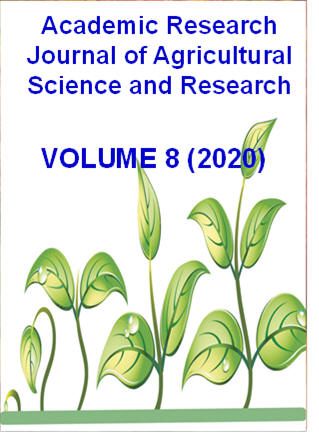|
ISSN: 2360-7874 |
Academic Research Journal of
Agricultural Science and Research |
|||||||||||||||||||
|
Vol. 8(2), pp. 82-97, March 2020 Research Response of Soybean Genotypes for Root, Nodulation, Growth, Yield and Yield Components to Lime and Phosphorus Application at Mettu, south western Ethiopia.
Tolossa Ameyu1, Abush Tesfaye2 and Alemayehu Regassa3
1Ethiopian Institute of Agricultural Research; Jimma Research Center P.O Box 192, Jimma, Ethiopia. 2International Institute of Tropical Agriculture, PMB 5320, Oyo road 200001, Ibadan, Nigeria. 3Department of Natural Resource Management, Jimma University, Post Box 378, Jimma, Ethiopia
Accepted 16 March 2020
Soybean (Glycine max L.) is one of grain legumes that are grown in tropical, subtropical and temperate climates. Acidic soils limit the productive potential of crops because of low availability of basic cations and excess of hydrogen and aluminium in exchangeable forms. This study was conducted to assess the response of soybean genotypes to lime and phosphorus. Treatments were laid out in a split-plot design, whereby four soil amendments were assigned to main plots and fifteen genotypes were assigned to the sub-plots. Treatment means were compared at 5% level of significance using Duncan’s Multiple Range Test. The results revealed that genotype x amendment interactions were significant (p<0.01) for all growth, root and nodulation characteristics and yield and yield components. The maximum grain yield of (2120 and 2047.2 kg ha-1) was obtained under Phosphorus alone and combined with lime from HAWASSA-04 variety and PI567046A genotype, respectively with non-significant variation; while the lowest (510.5 kg ha-1) were recorded from SCS-1genotype under the control treatment. Tolerance index value indicated that genotypes BRS238, PI567046A and variety HAWASSA-04 performed well for most of the traits and selected as tolerant. Significant and positive correlations were found for all growth, root and nodulation parameters with grain yield. The result of this study verified that application of lime (3457.8 kg ha-1) and Phosphorus (20 kg ha-1) improved the growth, root and nodulation characteristics yield and yield related traits of soybean genotypes. In conclusion, observation of large variation indicates that selection would be effective to improve soybean genotypes performance on acid soils and identify low Phosphorus tolerant genotype that helps smallholder farmers optimize soybean productivity on acid soils in the study area. Genotypes BRS238, PI567046A and HAWASSA-04 variety are the most tolerant among the tested materials. However, further study is required including more locations and years by considering additional genotypes, to determine the residual effect of phosphorus and lime to reach at a conclusive recommendation.
Key words: Amendments, Genotypes, Lime, Phosphorus, Soil acidity, Soybean
How to cite this article (APA Style): Tolossa A., Abush T., Alemayehu R (2020). Response of Soybean Genotypes for Root, Nodulation, Growth, Yield and Yield Components to Lime and Phosphorus Application at Mettu, south western Ethiopia. Acad. Res. J. Agri. Sci. Res. 8(2): 82-97
|
|||||||||||||||||||
